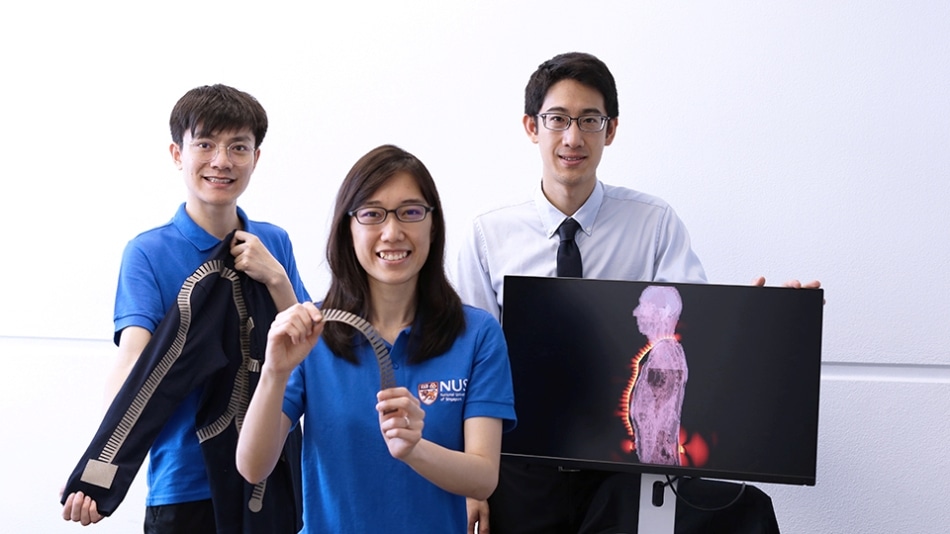Jul 18 2019
In the last 10 years, a big trend in electronics has been the progress of sensors, smart devices, and displays, which are flawlessly introduced into the human body. A majority of these wearable devices are singularly connected to a user’s smartphone and convey all data via WiFi or Bluetooth signals. But as consumers begin to wear more numbers of wearable devices, and as the data they convey becomes more sophisticated, highly advanced connection methods are the need of the hour.
 From left: PhD student Mr Tian Xi, Research Fellow Dr Lee Pui Mun, and Assistant Professor John Ho, together with seven NUS researchers, took a year to develop the “smart” textiles. (Image credit: NUS)
From left: PhD student Mr Tian Xi, Research Fellow Dr Lee Pui Mun, and Assistant Professor John Ho, together with seven NUS researchers, took a year to develop the “smart” textiles. (Image credit: NUS)
Presently, NUS scientists have come up with a new method for wearable devices to interconnect. They integrated conductive textiles into clothing to dynamically link many wearable devices simultaneously. This “wireless body sensor network” enables devices to convey data with 1,000 times stronger signal than conventional technologies, meaning the battery life of all devices is greatly enhanced. Wireless networks of these wearable devices on a body have future applications in medical interventions, health monitoring, and human–machine interfaces.
This technological innovation, which took the 10-member team a year to accomplish, was reported on the cover of Nature Electronics on June 17th, 2019.
Better data transmission, greater privacy
Presently, nearly all body sensors such as smartwatches connect to smartphones and other wearable electronics via radio-waves like WiFi and Bluetooth. These waves emit outwards in all directions, meaning that most of the energy is lost to the adjacent area. This technique of connectivity greatly diminishes the efficiency of the wearable technology as most of its battery life is consumed in an attempt to connect.
As such, Assistant Professor John Ho and his team from the Institute for Health Innovation & Technology (NUS iHealthtech) and NUS Engineering aimed to limit the signals between the sensors closer to the body to increase efficiency.
Their solution was to improve regular clothing with conductive textiles called metamaterials. Instead of transmitting waves into the immediate space, these metamaterials are able to develop “surface waves” which can glide wirelessly around the body on the clothes. This means that the energy of the signal between devices is kept close to the body instead of spreading in all directions. Hence, the wearable electronics consume a lot less power than normal, and the devices can sense much weaker signals.
This innovation allows for the perfect transmission of data between devices at power levels that are 1,000 times reduced. Or, alternatively, these metamaterial textiles could boost the received signal by 1,000 times which could give you dramatically higher data rates for the same power.
John Ho, Assistant Professor, Institute for Health Innovation and Technology, NUS Engineering
The signal between devices is so powerful that it is possible to wirelessly convey power from a smartphone to the device itself—paving the way for battery-free wearable devices.
Significantly, this signal optimization does not necessitate any changes to either the smartphone or the Bluetooth device—the metamaterial is compatible with any current wireless device in the designed frequency band.
This inventive way of networking devices also offers more confidentiality than conventional techniques. Presently, radio-waves convey signals several meters away from the person wearing the device, meaning that personal and sensitive information could be exposed to potential eavesdroppers. By restricting the wireless communication signal to within 10 m of the body, Asst Prof Ho and his team have developed a safer network.
Intelligent design, enhanced capabilities
The researchers have a first-year provisional patent on the metamaterial textile design, which comprises a comb-shaped strip of metamaterial on top of the clothing with an unpatterned conductor layer beneath. These strips can then be organized on clothing in any pattern necessary to link all areas of the body. The metamaterial itself is economical, in the range of a few dollars per meter, and can be purchased easily in rolls.
We started with a specific metamaterial that was both flat and could support surface waves. We had to redesign the structure so that it could work at the frequencies used for Bluetooth and Wi-Fi, perform well even when close to the human body, and could be mass-produced by cutting sheets of conductive textile.
John Ho, Assistant Professor, Institute for Health Innovation and Technology, NUS Engineering
The team’s specific design was developed with the help of a computer model to ensure effective communication in the radio frequency range and to enhance complete efficacy. The smart clothing is then made by laser-cutting the conductive metamaterial and fastening the strips with fabric adhesive.
Once created, the “smart” clothes are very robust. They can be folded and bent with nominal loss to the signal strength, and the conductive strips can even be torn or cut, without hindering the wireless capabilities. The clothes can also be washed, dried, and ironed similar to regular clothing.
Next steps
The researchers are in conversation with potential partners to market this technology, and shortly Asst Prof Ho is hoping to test the “smart” textiles as exclusive athletic clothing and for hospital patients to track health and performances.
Potential applications could vary greatly—from computing a patient’s vital signs without obstructing their freedom of motion, to regulating the volume in an athlete’s wireless headphones with a single hand motion.
We envision that endowing athletic wear, medical clothing and other apparel with such advanced electromagnetic capabilities can enhance our ability to perceive and interact with the world around us.
John Ho, Assistant Professor, Institute for Health Innovation and Technology, NUS Engineering
Source: http://nus.edu.sg/